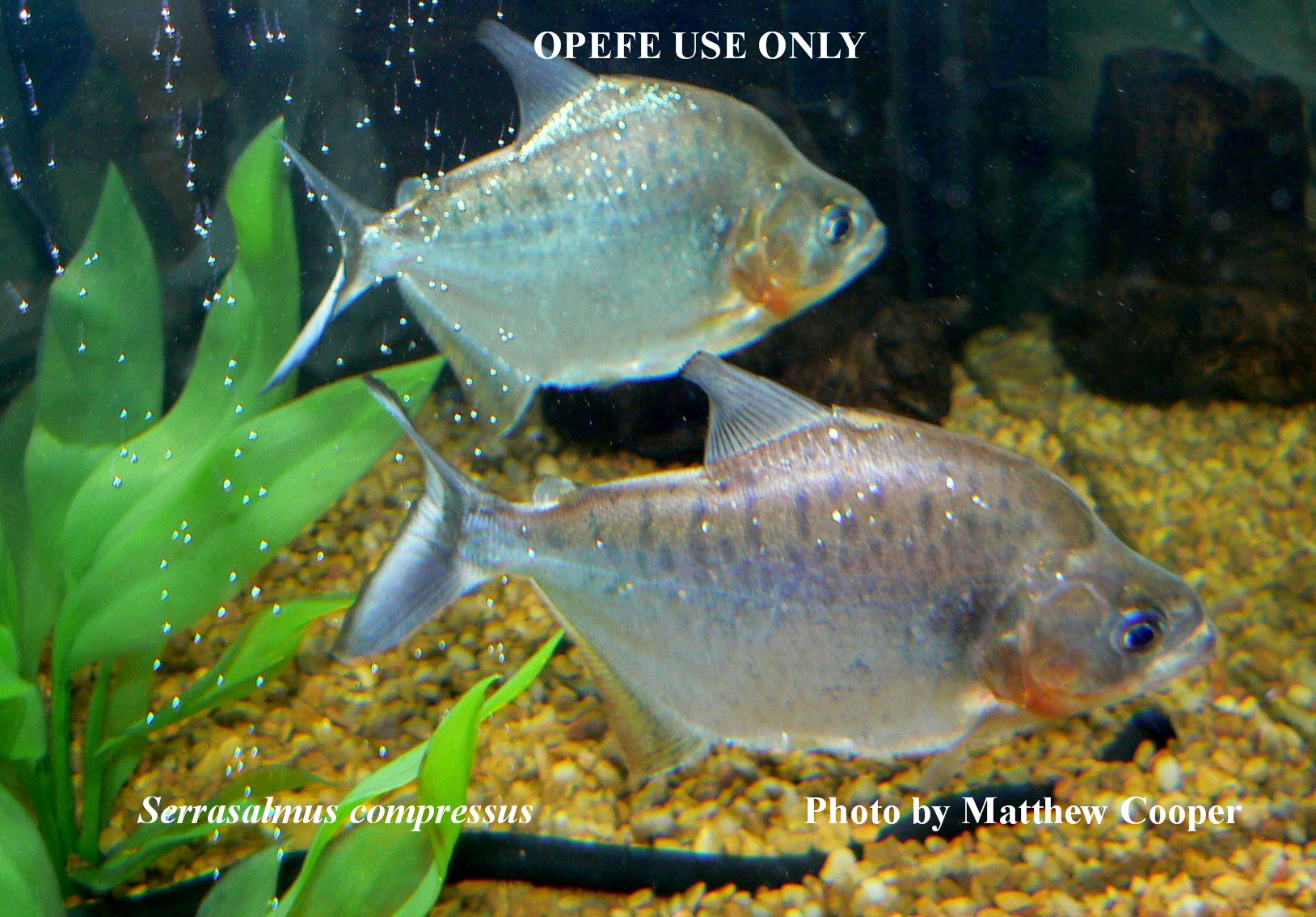 WELCOME TO OPEFE ARCHIVES
WELCOME TO OPEFE ARCHIVESSerrasalmus compressus
Jégu, M., E. L. M. Leão and G. M. dos Santos 1991
INTRODUCTION
This species is sometimes intermixed with S. rhombeus in shipments to hobbyists. Often confusing to pet shop dealers by its appearance and sometimes called a black piranha. It is a difficult species to separate from S. altuvei, but hobbyists should be aware that the methods described here are generally useful depending on the age and size of your fish. The bars and spots appear during certain times of growth and eventually become fixed. So it is quite possible to have a young specimen with just spots on the body, then later develop the bars. The common shape to look for is the compressed body and the snout which is very pointed and slightly turned upwards. They are very high-backed and the tail fin (caudal) may have only a thin band on the edge and giving it a "V" coloration from the caudal peduncle outwards. This coloration darkens with age giving it a more characteristic bold black tail band on the edge. Recently, this species has been at times sold by pet stores as S. hollandi, a totally different species found in Bolivia.
|
Good example of S. compressus |
Smaller specimen showing the typical markings. |
Finder markings, most unusual, but populations can be variable. |
Unusual markings may indicate a different species.
Also the anal to dorsal fin placement might suggest another compressus member, other than this one. The locality is relatively new. Will leave it here for now until more examles are caught. |
Young specimen |
Both S. compressus and S. altuvei look similar in body shape and color pattern, but the measurements for each separates them though it is subtle. S. compressus is more concave in profile in the supra-orbital region (back area) and more convex posterior to the supra-occiptial spine (just before the dorsal spine) than S. altuvei. S. compressus has a more robust snout laterally than S. altuvei. The ventral profile of the belly of many specimens of S. compressus ventrally protrudes to a greater extent anteriorly than S. altuvei. All these features are more pronounced in juveniles than adults. (FINK et al. 2001). Neither S. altuvei or S. compressus are common species. S. altuvei (Venezuela) is restricted to clear waters of the Venezuela Llanos. It is rare in collections and apparently rare in the wild. S. compressus is apparently restricted to the Rio Madiera and its tributaries (Jégu, 1991). Likewise is considered rare and collected with great effort. (FINK et al. 2001).
Photo far right, a species similar in appearance to S. compressus. The Piranha Book, Myers, G. S. 1972, Page 72.
IN THE AQUARIUM
PIRAMBEBA - Recommend keeping as solitary species in home aquarium. Fish is a fin biter and should not be grouped with any other species, including its own kind. 55 gallon aquarium, well planted with moderate aeration should be sufficient for its needs. The requirements would be similar to S. altuvei and care is required in handling them.
Color of Life
Pigment helps separate S. compressus from S. altuvei. Young S. compressus have larger and denser spots that extend more fully over the ventral body and belly than in S. altuvei, where spotting is sparse below the lateral line. (Fink, et al. 2001). The body color is gray metallic, the anterior thru basal of the anal fin is reddish with a black border. The caudal fin has a terminal black band. The other fins are hyaline. Some individuals present a black humeral spot. (Jégu, M., E. L. M. Leão and G. M. dos Santos, 1991). Eyes are reddish-orange. Ectopterygoid teeth common to Serrasalmus species are visible in this photo (upper left) of the upper palate of S. compressus.
Maximum Size
19.0 cm SL
Distribution
Middle Amazon River basin: Bolivia, Brazil and Peru.
A. Contributors and Advisors:
Fink, William L.
Jégu, Michel
B. REFERENCES
Fink, W. L. and A. Machado-Allison 2001 (16 Mar.) Serrasalmus hastatus, a new species of piranha from Brazil, with comments on Serrasalmus altuvei and Serrasalmus compressus (Teleostei: Characiformes). Occas. Pap. Mus. Zool. Univ. Mich. No. 730: 1-18.
Machado-Allison, Antonio., Fink, William., 1996 Los Peces Caribes de Venezuela, Diagnosis, Claves, Aspectos Ecologicos Y Evolutivos.
Jégu, M., E. L. M. Leão and G. M. dos Santos 1991 (July) Serrasalmus compressus, une espèce nouvelle du Rio Madeira, Amazonie (Pisces: Serrasalmidae). Ichthyol. Explor. Freshwaters v. 2 (no. 2): 97-108.
Merckx, A., M. Jégu and G. Mendes dos Santos 2000 (30 June) Une nouvelle espèce de Serrasalmus (Teleostei: Characidae: Serrasalminae), S. altispinis n. sp., décrite du Rio Uatumã (Amazonas, Brésil) avec une description complémentaire de S. rhombeus (Linnaeus, 1766) du plateau guyanais. Cybium v. 24 (no. 2): 181-201. [In French, English summ.]
Preserved specimen (top photo) donated by M. Mason, Columbus, OH, March 26, 2005.
USE YOUR BACKSPACE TO RETURN OR CLICK HERE TO RETURN SERRASALMUS LIST
USE THIS LINK TO RETURN TO RESEARCH PAGE.
The OPEFE web site and its contents; is disclaimed for purposes of Zoological Nomenclature in accordance with the International Code of Zoological Nomenclature, Fourth Edition, Article 8.3 and 8.4. No new names or nomenclature changes are available from statements at this web site.
Copyright© 1994-2012 Oregon Piranha Exotic Fish Exhibit (The OPEFE fish exhibit is permanently CLOSED as of 2000) Sutherlin, Oregon. Information posted on this web site is archival data on fish scientific classifications and other information. DISCLAIMER: The copyrighted material may not be used for any purpose other than private study, scholarship or research. Cited information requires credit and this link www.opefe.com. All rights reserved. All images shown (unless otherwise noted) is property of OPEFE.
UPDATED: 12/05/2015